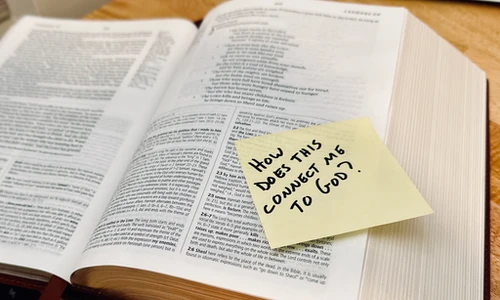What if God wasn’t Almighty?
What if Jesus wasn’t Lord?
What if forgiveness was just a myth we told ourselves at night?
In a world full of Christian confusion—denominational divides, doctrinal skirmishes, and hand-wave spirituality—statements of faith become boundary markers. Not to keep people out, but to keep us rooted and sure of where we stand.
I said the Apostles’ Creed every Sunday for decades without thinking too hard about what I was saying. So one day, I sat down to really study it, and I found myself asking, “What if this line weren’t true? What if I didn’t believe it? What would change?”
It started as just an experiment, but it ended up revealing the gospel more clearly than I would have imagined.
The Apostle’s Creed is one of the oldest and most common summaries of Christian belief we have. Millions of people recite it weekly.
Let’s flip it upside-down and find just how much is riding on every word.
What Is the Apostles’ Creed?
The Apostles’ Creed is one of the oldest creeds still existing today, historically attested no later than 390 AD and existing in various forms before that.
“Creed” comes from the Latin word “credo”, meaning “I believe.” It is, therefore, a statement of faith.
The Apostles’ Creed is famous, but there’s a much shorter and older one: “Jesus is Lord.”
3 Therefore I want you to understand that no one speaking in the Spirit of God ever says “Jesus is accursed!” and no one can say “Jesus is Lord” except in the Holy Spirit.
9 If you confess with your mouth that Jesus is Lord and believe in your heart that God raised him from the dead, you will be saved.
But we believe other things, too, and that’s where other, longer creeds come in. The most common modern creeds are the Nicene Creed, the Apostles’ Creed, and the Athanasian Creed. These creeds do two things: they declare what we do believe, and they counter certain heresies that have cropped up in the last two millennia. That is, by declaring every element of the creeds, we make sure we don’t accidentally stray into something unbiblical.
So to articulate what we truly believe, to strengthen our unity with other Christians, and to cultivate humility and curiosity about our own faith and others’ faiths, here’s the exercise: define the opposite of the Apostles’ Creed. If the Creed says what we do believe, what would it mean to deny each of its points?
What Does It Mean to “Invert” It?
Inversion is a classic problem-solving tactic for when you’re having trouble wrapping your head around how big your problem is. Inverting it might give you a simpler problem to solve; then you invert your solution to approach the original problem.
The Apostles’ Creed is a huge statement of faith, so there are two steps:
- Break it down into its constituent affirmations:
- I believe in God
- I believe in God the Father
- I believe in God the Father Almighty
- Invert each phrase
- I believe in God -> I do not believe in God
- I believe in God the Father -> God is not a Father
- I believe in God the Father Almighty -> God is not Almighty
- Ask what that inversion would mean
- If you reject the idea of God entirely, then you and I might still have a great conversation—but not a shared faith.
- If you reject God as Father altogether, you’re denying something essential about how He relates to us: intimately, relationally, and purposefully.
- If your God is missing powers, He isn’t the God of Scripture.
These inversions are a powerful way to test what you really believe, and whether you’re living like you believe it.
Before you keep reading, try it for yourself. Pick a few phrases, turn them around, and see what falls apart—and what keeps holding you up.
Here’s What This Looks Like in Practice
I divided the Creed into 23 phrases. Going through each of them would make this article 20,000 words long, so here are a few samples from my detailed study.
“I believe in Jesus Christ…”
🔁 Opposite
Jesus isn’t—or wasn’t—real. Or He’s real, but not the Christ.
💥 Result
This is where the Creed draws its sharpest line. You can be vague about God and get away with it at parties. But say “Jesus is the Christ,” and the room shifts.
Some people think Jesus never existed at all—a myth built by ancient Jewish sectarians stitching together prophecies and stories. Some think He was a real man, maybe even a prophet or miracle-worker, but not the Messiah. But the Creed says no: Jesus is the Christ—the anointed one, the promised deliverer, the fulfillment of every hope in the Hebrew Scriptures.
N.T. Wright often translates “Christ Jesus” as “King Jesus” to keep the title from getting swallowed into a name. And he’s right: calling Jesus “Christ” is a claim of cosmic kingship, not just religious affection.
C.S. Lewis put it bluntly: you don’t get to call Jesus a “great moral teacher” unless you’re prepared to call Him a deluded madman or a pathological liar. Because He claimed things that only God can claim. Which means you have to choose: Liar, Lunatic, Legend… or Lord.
If you deny Jesus as the Christ, you’ve stepped outside Christian orthodoxy. Maybe you’re spiritual. Maybe you’re curious. But you’re not Christian in the way the Creed defines it.
“…who was conceived…”
🔁 Opposite
Jesus never existed, or He wasn’t human, or He was created—not conceived.
💥 Result
“Conceived” might seem like a sterile, biological word—but this single phrase affirms one of the most radical ideas in Christianity: God became human from the very beginning.
Not just that Jesus showed up in a grown-up body. Not that He appeared in the form of a man like a divine illusionist. But that He started as an embryo. That He took on flesh—not just muscles and skin but cells, hormones, and bone marrow. That He gestated in a womb. That the incarnation didn’t skip the hard, messy, vulnerable parts of human life—it started there.
If you deny that Jesus was conceived, you risk sliding into ancient heresies like Docetism, which claimed Jesus only seemed human. But Scripture is stubbornly earthy: Jesus hungered, bled, cried, and died. And that starts here—with conception.
To be our Savior, Jesus had to be fully human. Not just look human. Not just act human. Be human.
And being human starts with being conceived.
“…the communion of saints…”
To be honest, this phrase was by far the hardest for me to understand what it is I mean when I say it. The next few paragraphs took me a long time to write.
🔁 Opposite
Faith is solitary. The Church is only the people I can see. The dead are gone, and the living are strangers.
💥 Result
We’re not just a church. We’re a communion.
Not (just) a potluck. Not (just) a committee. A mystical fellowship that stretches across death, distance, language, and denomination.
The “communion of saints” means:
- You are never alone.
- Your story isn’t just yours.
- The cloud of witnesses is still watching, still worshiping, still cheering us on (Hebrews 12:1).
It includes:
- Saints of the past (Abraham, Mary, your grandmother).
- Saints of the present (your friend from Bible study, your pastor, that lady with the tambourine).
- Saints of the future (your children’s children; those not yet born or not yet saved).
To believe in this communion is to stand in a chorus echoing through centuries, singing the same God’s praises.
Even in solitude, you are part of a living, dying, rising body.
This is not ancestor worship; it’s sacred solidarity with the past, the present, and the future.
It is the eternal togetherness of all who are in Christ.
What This Exercise Taught Me
The Apostles’ Creed is a basic statement of faith, but it’s not just theology; it’s security. Every line is an anchor into what I believe. Now that I’ve made every phrase concrete and rich for myself, I can go back to it again and again to be refreshed and renewed in the basics of my faith, and that stability empowers the rest of my life.
I don’t just want to recite the Creed. I want to believe it.
Want to try it yourself?
Download the free worksheet below to start inverting the Creed—just one phrase at a time. I’ve filled in the couple of lines to get you started; the rest is yours to explore.
You’ll also be the first to get the full (free) study guide when it’s ready.



